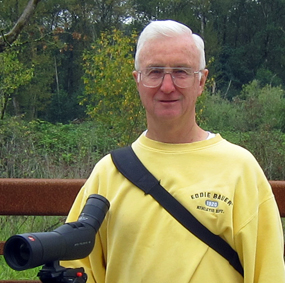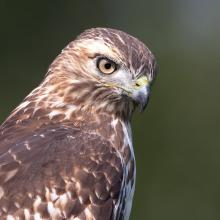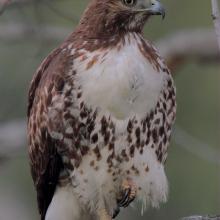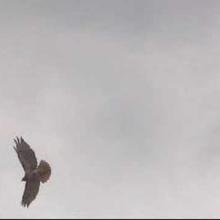

Join BirdNote tomorrow, November 30th!
Illustrator David Sibley and actor H. Jon Benjamin will face off in the bird illustration battle of the century during BirdNote's Year-end Celebration and Auction!
Driving the freeway or a narrow country road, you may glance up at a light pole where a large hawk sits in plain view. If it's brown and somewhat mottled, and its small head and short tail make it appear football-shaped, it's probably a Red-tailed Hawk. During winter, many Red-tailed Hawks move south, joining year-round residents.
BirdNote gives you the sounds of birds everyday. And you get the sights as well when you follow us on Instagram. @BirdNoteRadio
BirdNote®
Freeway Hawks
Written by Frances Wood
This is BirdNote. [Call of Red-tailed Hawk]
Driving the freeway, [traffic noise] perhaps just inching along in traffic, you happen to glance up to an overhead light post where a large hawk sits in plain view. It’s brown, somewhat mottled; a small head and short tail make it appear football-shaped. It’s a Red-tailed Hawk. [More calling]
During winter, many Red-tailed Hawks move south, joining year-round resident pairs, to feed on mice, voles, and other small mammals. The freeway’s wide center medians and mowed shoulders offer a mini-habitat of open grassland where Red-tailed Hawks watch for prey. And the light posts, telephone poles, and nearby trees offer excellent viewing perches.
The red tail of the “Red-tail” may be hard to see, since folded wings often cover it. If your view is of the bird’s front, watch for a dark bellyband across the lower part of a pale chest. If your view is of the back, try to observe a white spotted “V” in the center of the back. You’ll see the red tail when it flies. Perhaps a bit of freeway birdwatching may ease the frustration of slow traffic, so watch for this bulky football of a hawk. Once Red-tails find a successful hunting area, they return often. [Repeat calling]
For BirdNote, I'm Mary McCann.
BirdNote gives you the sounds of birds everyday. And you get the sights as well when you follow us on Instagram. At BirdNoteRadio
###
Bird sounds provided by The Macaulay Library at the Cornell Lab of Ornithology, Ithaca, New York. Recorded by G.A. Keller.
BirdNote's theme music was composed and played by Nancy Rumbel and John Kessler.
Producer: John Kessler
Executive Producer: Dominic Black
© 2014 Tune In to Nature.org December 2016/2018/2021 Narrator: Mary McCann
ID #: 110105RTHA RTHA-02b








